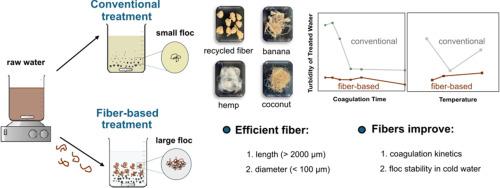纤维性能对絮团形成和除浊的影响
IF 7.1
Q1 ENGINEERING, CHEMICAL
引用次数: 0
摘要
水处理行业对在混凝和絮凝过程中减少化学品需求的可持续方法很感兴趣。在常规的物理化学处理中,降低水温可以减缓颗粒碰撞、化学反应、絮凝体形成和絮凝体沉降速度。本研究探讨了使用纤维基超桥接剂来补偿温度对混凝过程的影响。在不同温度下的实验室规模(250 mL)中评估了再生纤维素纤维的功效,证明了沉淀和筛选作为絮凝分离方法的高浊度去除。对于基于纤维的处理,在温度接近5°C, 10°C和20°C时的浊度差异很小,这表明该技术比传统方法(混凝剂和絮凝剂)更有效,传统方法在温度之间表现出显着的变化。此外,无论纤维来源和性能如何,不同的纤维素纤维都可以作为超桥接剂有效地去除浊度。另外还进行了实验,以了解纤维长度和直径分布对纤维基处理性能的影响。长度为2000µm、直径为100µm的纤维在降低浊度方面更有效,并且在混凝和絮凝过程中转化为更低的化学需用量(即,在目标水质为20 NTU时,明矾需用量减少20%)。这种可持续的基于纤维的水处理方法有可能降低在不同季节和地理位置的不同水温下运行的水处理厂的运营成本,尽管需要进行技术经济分析来验证这一假设。本文章由计算机程序翻译,如有差异,请以英文原文为准。

Impact of fiber properties on floc formation and turbidity removal
The water treatment industry is interested in sustainable approaches to minimize chemical demand in the coagulation and flocculation process. In conventional physicochemical treatment, lower water temperatures act to slow down particle collisions, chemical reactions, floc formation, and floc settling rates. This study explored the use of fiber-based super-bridging agents to compensate for the effect of temperature on the coagulation-flocculation process. The efficacy of recycled cellulose fibers was evaluated at the lab scale (250 mL) at various temperatures, demonstrating high turbidity removal with both settling and screening as floc separation methods. For the fiber-based treatment, turbidity differences at temperatures near 5 °C, 10 °C, and 20 °C were minimal indicating that this technology is more effective than the conventional approach (coagulant and flocculant) which showed significant variations between temperatures. Furthermore, regardless of the fiber source and properties, different cellulose fibers were efficient in turbidity removal acting as a super-bridging agent. Additional experiments were conducted to understand how fiber length and diameter distributions influenced the performance of the fiber-based treatment. Fibers of length > 2000 µm and diameter < 100 µm were more efficient in reducing turbidity and translated to lower chemical demand (i.e., 20 % reduction in alum demand for a target water quality of 20 NTU) in the coagulation and flocculation process. This sustainable fiber-based water treatment approach has the potential to lower the operational cost of water treatment plants operating at different water temperatures as a function of the season and geographical location, though techno-economic analysis is required to validate this hypothesis.
求助全文
通过发布文献求助,成功后即可免费获取论文全文。
去求助
来源期刊

Chemical Engineering Journal Advances
Engineering-Industrial and Manufacturing Engineering
CiteScore
8.30
自引率
0.00%
发文量
213
审稿时长
26 days
 求助内容:
求助内容: 应助结果提醒方式:
应助结果提醒方式:


